
| In
our periodical newsletter, we continue our focus on providing our national and
international partners and colleagues with up-to-date information on the progress
of our activities at ICHARM. | ||||||||
| Voi.3 No.1 (Issue No.7) | ||||||||
| | ||||||||
| 1. Message from the Director | ||||||||
| Happy New Year! On New Year's Day, the Pacific coast of Japan, where Tsukuba is located, was favored by good weather, and we celebrated the beginning of a new year in bright, warm sunshine. At the dawn of a new year, I sincerely wish, and I would like to invite everyone, to pray that every corner of the world will be blessed with peace and fewer disasters this year. Last year, the world suffered a series of major flood disasters. One that is still fresh in our memory is the catastrophic flooding caused by Cyclone Sidr in November, which led to more than 3,000 deaths in Bangladesh. In 2007, floods occurred one after another, for instance, in Britain, China and on the Indian subcontinent. In a different way, the year was also unforgettable because the international response to climate change made a landmark turn to take the next concrete step. This was spurred by several key events, such as the G8 Heiligendamm summit, publication of the 4th Assessment of the IPCC report, the Nobel Peace Prize being awarded to Mr. Al Gore and IPCC, and COP13 held in Bali this past December. Under these circumstances, the year 2008 needs to see tangible progress in policy development with the focus on both mitigation and adaptation measures to combat climate change. The G8 Toyako summit, to be hosted by Japan in July, will be a touchstone to test the participating countries' determination on the issue. ICHARM is ready to make the utmost contribution to the formulation and implementation of necessary measures. The first Asia-Pacific Water Summit was held in Beppu, Japan, under the general theme of "Leadership and Commitment" last December. Various stakeholders - politicians, high-level government officials, and experts - within and without the region attended. The summit was a great success in that the participants agreed on the urgency of water resources security and adaptation to climate change and, in turn, the importance of immediate political action. ICHARM was assigned to be the lead organization on one of the primary themes of water-related disaster management, and we were grateful to be given such an opportunity to have our voice heard. This summit must not come to be seen as just another "get-together" event. The participants must commit themselves to implementing the agreed-upon proposals. ICHARM is no exception. We are fully aware of the urgency of the issue, and are ready to fulfill our commitments. One of our commitments is to play a role as a water knowledge hub and create a global network to promote capacity development, technical transfer, and reformation in various areas in the water-related field. In particular, ICHARM acknowledges the importance of the development and implementation of support programs in collaboration with implementation organizations, such as the Asian Development Bank. Such programs include those for disaster-vulnerable areas suffering, for instance, possible glacier lake outburst floods and island transgression. Other commitments include hydro-metrological monitoring, the development of early forecasting/warning systems, and the development of global water-related disaster risk assessments and indices, to name a few. The monitoring of progress in the mitigation of water disasters is also important, once such assessments are set in place. Still more important is to enhance the ICHARM-led Master's course in water-related disaster management. Currently, ten highly ambitious participants are studying intently under a tightly scheduled course curriculum, and the ICHARM staff, including myself, is looking forward to the course's first graduation in September 2008. Later this year, the 17th UNESCO-IHP Intergovernmental Council and the 2nd ICHARM International Advisory Board Meeting will be held. These meetings will be good opportunities for ICHARM to show that our accomplishments live up to global expectations and to prove our value in the field of water risk management. ICHARM will take solid, concrete steps to achieve these goals. As ICHARM director, I appreciate the further continued support for ICHARM from many individuals and organizations. | ||||||||
 Dr. Kuniyoshi Takeuchi Director of ICHARM
| ||||||||
| | ||||||||
| 2. Introduction of new ICHARM staff | ||||||||
| i. Dr. Rajapakse | ||||||||
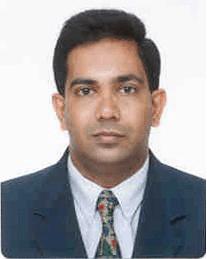 Dr. Hemantha Rajapakse, Sri Lankan national, joined ICHARM in December 2007 as a researcher in the Hydrologic Engineering Research Team. His current primary research interest concerns basin-wide nutrient dynamics modeling. He attended Ananda College, Colombo, then entered University of Moratuwa, Sri Lanka in 1992 and graduated with first class honors in June 1996, majoring in Civil Engineering. After serving a one year term as an academic instructor, he came to Saitama University, Japan, in October 1997 and completed his Master's degree in Civil and Environmental Engineering in September 1999. His research focused on the management of groundwater resources to mitigate land subsidence in Kanto Basin using real-time telemetry data, automated computer analysis and optimization modeling. |
Afterwards, he accepted a Research Engineer position at the High Performance Concrete Research Laboratory (HPCRL) at National University of Singapore (NUS), and conducted research on the design criteria for concrete based desalination plants for mass scale water purification. Then he joined the leading Dutch dredging and marine construction company Jan De Nul as a Planning Engineer for its US$ 1.8 billion land reclamation project off Changi Airport, Singapore. He came to Saitama University again in October 2002 to commence his PhD studies, and the core research comprised of a collaborative study with two Australian universities to monitor eco-physiological characteristics of temperate wetland and lake ecosystems with special reference to ecological modeling of responsive adaptations of wetland species to environmental variations. After completing his PhD studies in September 2005, he joined the same laboratory as an Invited Researcher and then served as a JSPS (Japan Society for the Promotion of Science) postdoctoral fellow from April 2006, until he joined ICHARM. | |||||||
| ii. Dr. Yorozuya | ||||||||
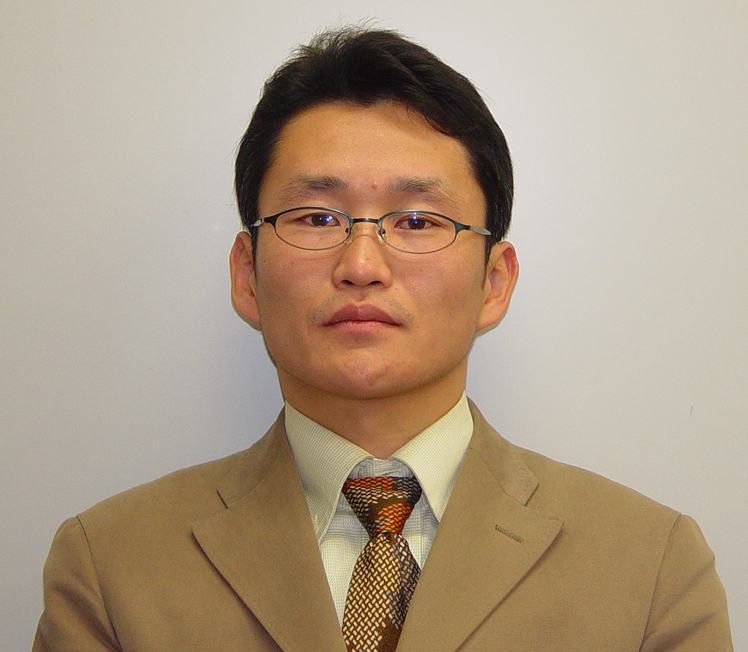 Dr. Yorozuya joined the Hydrologic Engineering Research
Team of ICHARM as a researcher on January 1st, 2008. He now helps the team with
a hydraulic research on the improvement of observation accuracy of flood discharge. He earned bachelor's and master's degrees in Chuo University, Tokyo Japan.
He conducted an experimental study on the micro physics of clouds in the vertical
shaft of mine. Also, he analyzed hydrometeorological data to identify the causes
of debris flows. |
After working at Hiroshima University for one year, he enrolled in a graduate program at the University of Iowa in the United States. Studying at the C. Maxwell Stanley Hydraulics Laboratory, IIHR-Hydroscience & Engineering Department, he dedicated himself to experimental studies about a scour around bridge abutments, for which he obtained a Ph.D. In January 2006, he accepted the position
of a temporal researcher in the National Institute for Land, Infrastructure, Transport
and Tourism (NILIM). His work at NILIM was to develope an observational system
for measuring stream discharge and bed elevation during flooding, and to conduct
inundation analyses using laser profiler data. After his two year's research work
at NILIM, he joined ICHARM. | |||||||
| | ||||||||
| 3. Recent Report | ||||||||
| i.
Cyclone Sidr damage assessment in Bangladesh (8. ~ 18. Dec.) | ||||||||
| On November 15, 2007, Cyclone Sidr landed in southwestern Bangladesh, causing huge damage due to strong winds and violent storm surges. Mr. Shigenobu Tanaka, team leader of the ICHARM International Technical Exchange Team, visited several affected areas from December 8 to 18 as a member of the needs assessment team to support cyclone disaster restoration in Bangladesh. Approximately 140 million people live in Bangladesh, a country with a total area of 144,000 km2 (about a fourth the size of Japan). Bangladesh is one of the world's most densely populated countries, with a population density of 976 persons per km2. Geographically, the country is mostly made up of low-lying deltas formed by the rivers of Ganges, Brahmaputra, and Meghna. As of December 27, the number of disaster victims had reached 8,920,000, including 3,363 deaths. The most severely affected areas were concentrated in the districts of Pirojpur, Patuakhali, Bagerhat and Borguna, which were located in the southwestern part of the country, where the cyclone landed. Figure 1 shows the geography of the affected areas and the course of the cyclone. Many rivers meander through the areas and empty into the Bay of Bengal, and low-lying deltas along the rivers are only about two meters above sea level. Bangladesh had created polders to prevent inundation disasters, and the total length of levees reached approximately 10,000 km as of June 2006. When Sidr hit the country this time, the levees were breached in many places, and the length of the breached levees reached 367 km. A total of 2,015 km were partially damaged. There was also structural damage, including sill sedimentation in river channels, damage to sluice gates, and destruction of revetments. Many public infrastructures, such as roads, bridges and schools, were also destroyed. Sidr was an extremely powerful cyclone with an average maximum wind speed of 69 m/s and a lowest atmospheric pressure of 994 hPa. Storm surges reached a height of 4-5 m in some areas despite the low tide period, overtopped levees and caused extensive damage. |
Trees fell and house roofs were blown away in many areas in the cyclone's path. It is not so difficult to imagine that the damage could have been fur more serious if the cyclone-induced storm surges had hit the areas during high tide. When the team visited the areas, relief supplies had been provided and people seemed to have settled down to some extent. Considering that there is no higher ground nearby for evacuation, however, if the levees are not restored by the monsoon season, which starts in April, they will be forced to lead their lives with a tremendous fear of future water-related disasters. Restoration needs to be done as soon as possible to prevent another Sidr-like disaster. Figure.1. | |||||||
|
| ||||||||
 |
 | |||||||
| Photo 1 shows the remaining part of the levee, located north of a breach point (about 600 m wide) at Padma Hat, five kilometers southwest of Patharghata in the Barguna district. The remaining part of the levee was about 4.5 m high when the assessment team visited the site, and it had suffered severe damage due to overtopping. Taking a close look at the photo, one can see concrete blocks placed on the river side of the levee for its protection, although these were scattered by storm surges. |
Photo 2 shows the remains of a high school that had been built using reinforced concrete. This exemplifies the huge external force of storm surges that hit the school, which stood right at a breach point. | |||||||
 |
 | |||||||
| Photo
3 shows a building totally destroyed by storm surges. The building is located
60 km upstream from the river's mouth. Storm surges hit it from the right-hand
side and knocked it down. |
Photo 4 shows a private home located about 30 km upstream from
the river's mouth. Storm surges swept away part of the house and even rotated
it to some degree. | |||||||
|
| ||||||||
| 4. Training | ||||||||
|
i. Self-introduction of 5 students at Master's Degree Program "Water-related Risk Management Course of Disaster Management Policy Program" | ||||||||
|
Mitra Baral Water Induced Disaster Prevention Department, Nepal
At present, I came to know about the effective role of Japan in disaster management and support for participating countries. Really, Japan is transferring knowledge and technology which is an essential and primary tool for disaster mitigation program. Apart from studying we are participating in many programs like public interaction, cultural exchange, course specific field observations which upgrade our knowledge and experience in technical, administrative, social and management fields. Such support from Japan will be certainly helpful to achieve everlasting peace in the world through sustainable development. Japan is facing many types of water-induced disasters since its origin. Japanese have ample experience in these fields and developed technologies to take countermeasures against them. Much effort has been set up to combat the impacts of global warming. So in my opinion, ICHARM is the best place in the world to learn about water-induced disasters and mitigation techniques. |
Muhammad Masood Water Development Board, Bangradesh
I am getting kind cooperation from all participants and experts of ICHARM for my study. I am also enjoying my time in Japan, especially in Tsukuba with comfort. Bangladesh is a disaster-prone country like Japan. So, as a participant from Bangladesh, I need the knowledge about how Japan faces the challenge of natural disasters. This course is reflecting the efforts of Japanese people to minimize the loss of lives and properties during disasters by using experience, knowledge and technology. I hope my acquired knowledge from Japan will be very helpful for my country. | |||||||
| Zhou Ji Water Resource Conservancy Bureau, Wuxi-city, China
The schedule at ICHARM is reasonable and makes me feel like I have a good
harvest everyday. Professors and staff are knowledgeable and willing to help people,
especially foreign students like me. Also thanks to JICA , its bus service makes our everyday transportation very convenient. JICA staff also gives us necessary support in many aspects. In a word, Japanese people are kind and willing to help us, and their good intension and knowledge make me feel more responsible to devote myself to water resource conservancy. |
Hirohisa Miura Japan Water Agency, Japan
Also, I have never worked with foreign experts. So, I think that this experience with trainees from all over the world will be extremely valuable for me. Three months has passed since the course started, and I have obtained a lot of new knowledge. I am looking forward to being able to do a lot more studies. | |||||||
| | ||||||||
| Ryota Ojima CTI Engineering Co. Ltd. Japan
In October 2007, I was fortunate to have an opportunity to study at ICHARM . I really appreciate proffessors and ICHARM staff providing us this excellent program, including field trips and exercises. |
Life in TBIC I'm presently staying at TBIC with my friends coming from various countries and regions, including Asia, Middle East and Africa. It is very good experience for me to understand different cultures and ways of thinking. Studying with various students helps me acquire not only knowledge but also precious experience and friends. | |||||||
|
ii. Results of 2007 region-focused training course on flood hazard mapping (FHM) (30. Oct. ~ 29. Nov.) | ||||||||
|
The Flood Hazard Mapping Training Course 2007 was held from October 30 through November 29 in cooperation with the Japan Cooperation Agency. This training course is specifically designed for engineers and technicians in the field of river works and flood management in their countries. This year, there were 20 participants from nine different countries, including Cambodia, China, Indonesia, Laos, Malaysia, Sri Lanka, The Philippines, Thailand and Vietnam. The objective of this training course is two-folded. First, participants acquire the techniques of making and disseminating Flood Hazard Maps. Second, they also learn about flood hazard mapping in different countries, including Japan and other developed countries. We believe that these two factors will help them develop the capacities for effective flood hazard mapping. Curriculum of this course is composed of mainly four activities as follows; Lectures: ICHARM invited several lecturers from other research institutes, such as UNESCO-IHE. The lectures cover a wide range of areas in relation to flood hazard mapping, including flood situations and current status of flood hazard mapping, new techniques (e.g. remote sensing) to obtain different kinds of data to make flood hazard maps, disaster prevention education, and integrated flood management. Exercises: The participants performed run-off analysis, GIS handling, inundation simulation and flood hazard mapping by themselves in the exercise time. They used several kinds of technical software, such as Minitab for run-off analysis, ArcView9.1 for GIS handling and HEC-GeoRAS and HEC-RAS for inundation simulation Field Surveys: The participants conducted field surveys called "Town Watching" with help from Kurihashi Town and Ise City. In this training, they actually walked around the towns while interviewing local residents and community leaders to find out dangerous points along evacuation routes, the level of residents' awareness towards disaster prevention, and the effectiveness of the current flood hazard maps. Group Discussions: Each group conducted discussions to classify problems they found in the field surveys and to come up with solutions to those problems. They also made suggestions to improve the current status of disaster prevention and flood hazard maps of Kurihashi Town and Ise city |
This year, the contents of the training course were improved based on the issues form last year and the opinions from the participants of the previous course. Especially, the allocated time and contents for the exercises and Town Watching were largely enhanced. All the participants successfully performed inundation simulation and made their own flood hazard maps for Ise City by using the provided base data and the results of Town Watching. This means that they are now prepared to make flood hazard maps from the beginning by themselves for any area in their countries, if they can collect necessary data. Furthermore, each participant wrote a concrete action plan of their own, which should help them take concrete action in river works and/or flood management after going back to their countries. Finally, we at ICHARM would like to express our sincere gratitude to lecturers and those who helped us with Town Watching despite their busy schedules. | |||||||
| | ||||||||
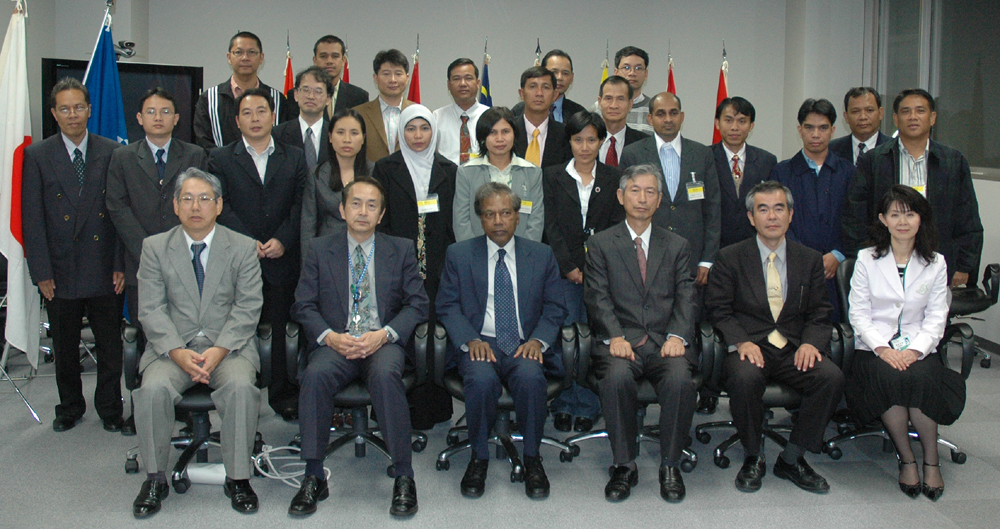 |
 | |||||||
| Participants
with the course organizers (front row) at the opening ceremony |
Participants looking over lecture handouts | |||||||
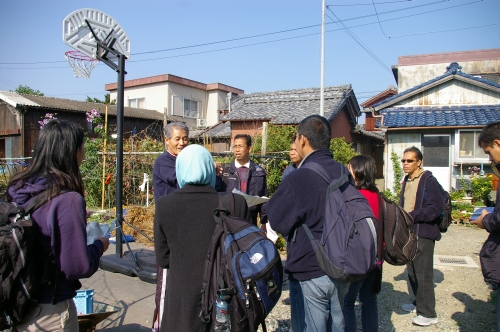 |
 | |||||||
| Participants
interviewing a resident in Town Watching |
Participants discussing in groups | |||||||
| | ||||||||
| 5. ICHARM-hosting conferences | ||||||||
| i. ICHARM Quick Report on Floods 2007 (6. Nov.) | ||||||||
| The International Centre for Water Hazard and Risk Management of the Public Works Research Institute (ICHARM/PWRI) held a symposium, "ICHARM Quick Report on Floods 2007," on November 6 at the ICHARM auditorium. This symposium was held to celebrate the eagerly awaited completion of this auditorium. The auditorium with a capacity of about 60 people was filled with participants, including 29 foreign trainees presently studying at ICHARM in addition to professors, experts in water-related disasters, and researchers of PWRI and the National Institute for Land and Infrastructure Management. Dr. Sakamoto, PWRI chief executive, started the proceedings. He expressed concerns over extraordinary meteorological phenomena which have frequently occurred on a global scale in recent years. Speaking about flood events which occurred this year in southern China, Britain, India and African countries, he hoped that the symposium would offer significant insights into how the world should prepare for such phenomena. Dr. Takeuchi, ICHARM director, also spoke at the beginning of the symposium. He said that adaptation to predicted climate change in the future was one of the important keywords for ICHARM to conduct various activities to prevent or mitigate water-related disasters. He also told the audience that ICHARM would provide occasions like this symposium to proactively inform the public, experts, and other relevant parties about water-related issues. For this symposium, ICHARM invited two foreign experts. Dr. Kuang Shangfu, director general of the China Institute of Water Resources and Hydropower Research, was the first speaker and gave a presentation entitled "Flood Disaster and Flood Countermeasures in China." He explained that damage which inflicted on China by water-related disasters was decreasing in the 1990s and 2000s, but still accounted for 1.8% of the country's GNP. He also pointed out that human loss in flood events had been consistently decreasing since the 1950s, while economic loss per unit area had been increasing. |
He then described China's flood control measures. According to Dr. Kuang, since the Yangtze Great Flood in 1998, China's Ministry of Water Resources has taken action based on three fundamental policies: 1) Consider both floods and droughts as priority issues; 2) Promote a shift from flood control to flood management; 3) Create harmonious coexistence between humans and floods. He discussed specific disaster events to explain how China tries to handle them using structural measures, such as the Three Gorge Dam, detention/storage zones and levees, and non-structural measures, such as the China Water Law, revision of relevant laws and flood hazard mapping. The audiences were amazed by the gigantic scale of the disasters in his presentation. Dr. Ian Cluckie, director of the Water and Environmental Management Research Centre at the University of Bristol, spoke after Dr. Kuang. He reported on the 2007 flood disasters in southern Britain and lessons learned from the disasters in his presentation, "Flood Related Disasters in the UK." Pointing out that rainfalls in some parts of the country exceeded the return period of 200 years, he said, "if risk changes as a result of climate change, the concept of return periods becomes meaningless." He also told the audience that storm surges were of more serious concern in Britain than floods in relation to climate change. Dr. Cluckie ended his presentation emphasizing the importance of the collaboration between the areas of meteorology and environmental studies for future action. After the two foreign experts, Mr. Mori gave a presentation about the recent trend of flood disasters in Japan and possible countermeasures to respond to an increasing frequency of torrential rains in recent years. He is the senior deputy director of the Disaster Risk Management Office, Disaster Prevention and Relief Division, River Bureau, Ministry of Land, Infrastructure and Transport. A panel discussion followed the three presentations, with Dr. Takeuchi as moderator. The presenters and the audience actively exchanged questions and answers as well as opinions about adaptation strategies for flood disasters due to global climate change, which is highly likely to occur in the future. | |||||||
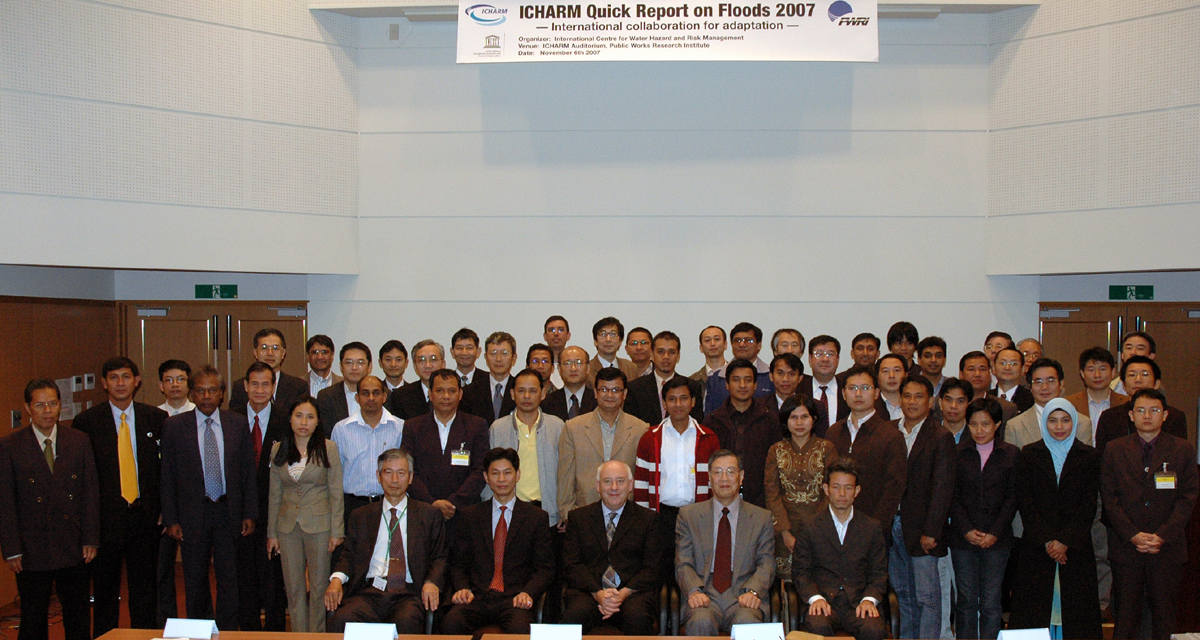 |
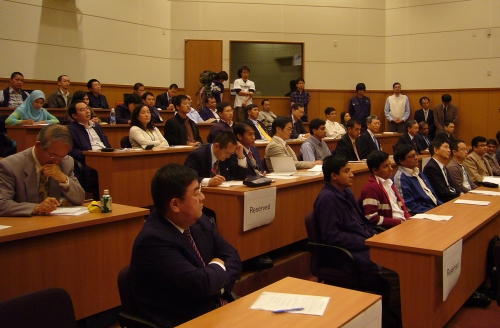 | |||||||
| The participants and
presenters gather for a photo in the new ICHARM auditorium. | The audience intently listen to a presentation. | |||||||
| ii. Asia Pacific Water Forum (1. ~ 4. Dec.) | ||||||||
|
The 1st Asia Pacific Water Forum was held on 3 and 4 Dec. 2007 in Beppu city, Japan, where high-level policymakers and various other notable guests were invited to discuss and share views on the ways to better manage water-related issues, thus contributing to concrete actions. One of main issues raised was anticipated adverse effects on water-related issues related to the climate change, including water-related disaster management. ICHARM undertook the responsibility of
lead organization on "Water-related Disaster Management", which was
one of three priority themes set for the APWS. While ICHARM highly contributed
to preparation of the "Policy
Brief", which includes key messages and recommendations to the participants,
it organized two major events in Beppu, as introduced below. |
| |||||||
| 1.
Open Event; On 2 Dec., ICHARM, jointly with the River Bureau of the Ministry of Land, Infrastructure and Transport, organized an symposium titled "Integrated approach to water-related disaster management", which was open to the public. Various opinions and views were presented by guests from international organizations, academia and government sectors. The main focus was anticipated climate change. It was agreed that adaptation is as important as mitigation in coping with climate change, and that adoption of flexible adaptive measures is necessary to realize an integrated approach to water-related disaster management. |
The result of discussion was compiled as Messages from the symposium to the APWS participants for consideration. Please click here (link) for the program of this open event, and Power-point files of some presentations. Please visit the following website for general information of each open events. http://www.reg-clinkage.jp/apws/openevent/project/index.html | |||||||
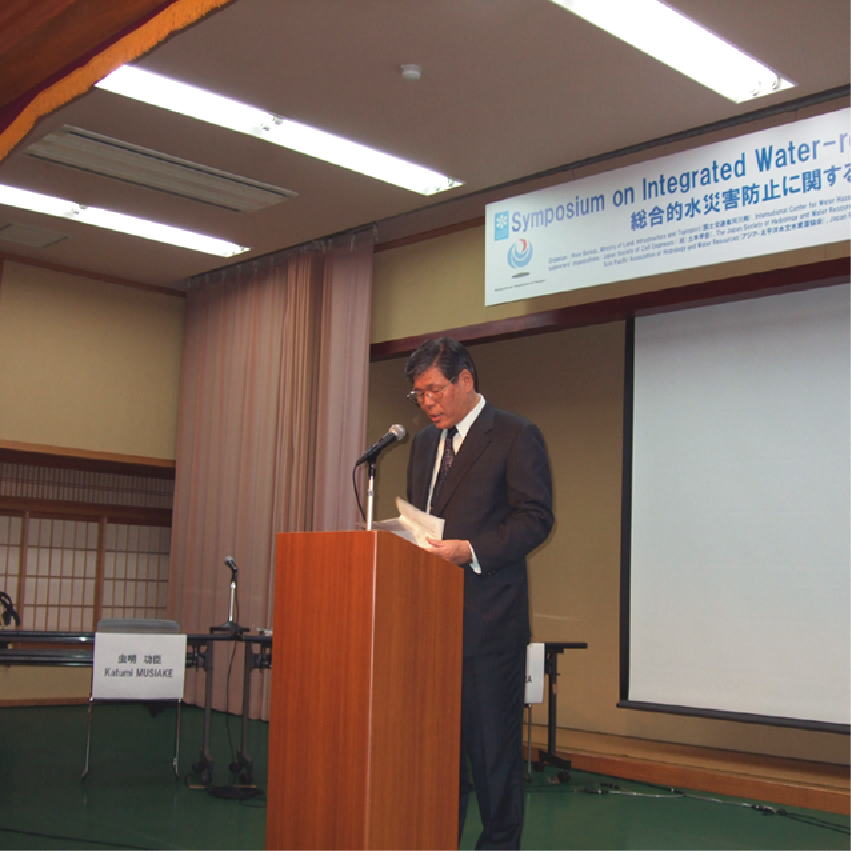 |
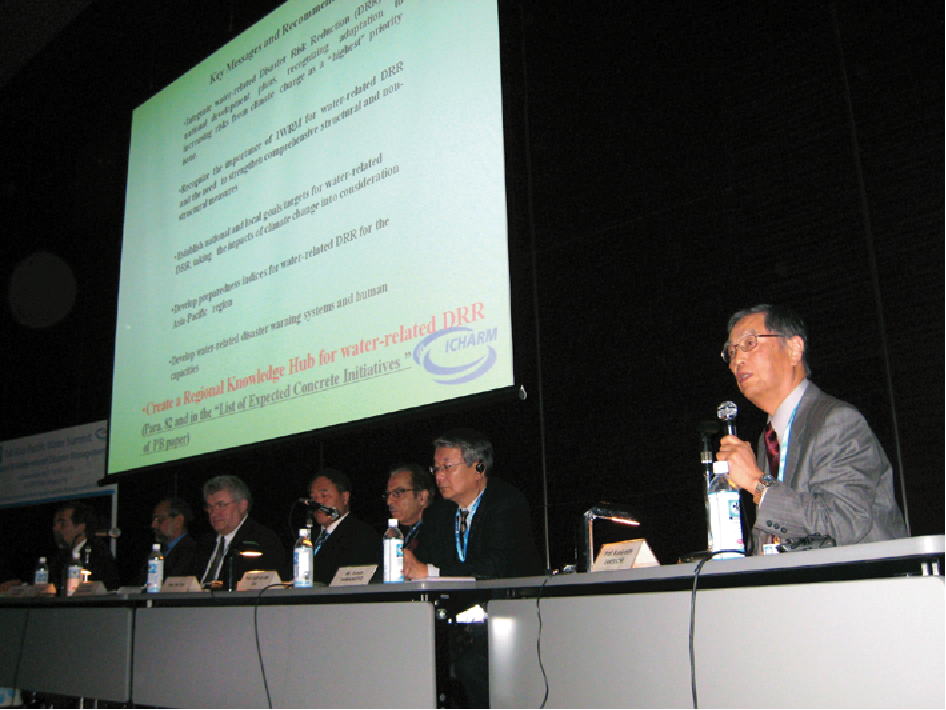 | |||||||
| Mr. Taniguchi, Vice-Minister
for Engineering Affairs of MLIT, makes an speech at the symposium. | Dr.
Takeuchi explains the "Messages from the symposium" to the APWS participants. | |||||||
| 2. Session on "Water-related Disaster Management" On 4 Dec. 2007, ICHARM organized as session of "Water-related Disaster Management" as part of the Summit Program, inviting high-level policymakers, representatives from international organizations and academic experts. After receiving precious policy directions, etc., from presenters, the participants agreed on the key messages that need to be addressed for better managing water-related disasters. |
The results were presented by Prof. Takeuchi, Director of ICHARM, at the closing ceremony of the 1st APWS. Please click here (link) for the program of this session, and Power-point files of some presentations. Please visit the following website for general and comprehensive information on the 1st APWS. | |||||||
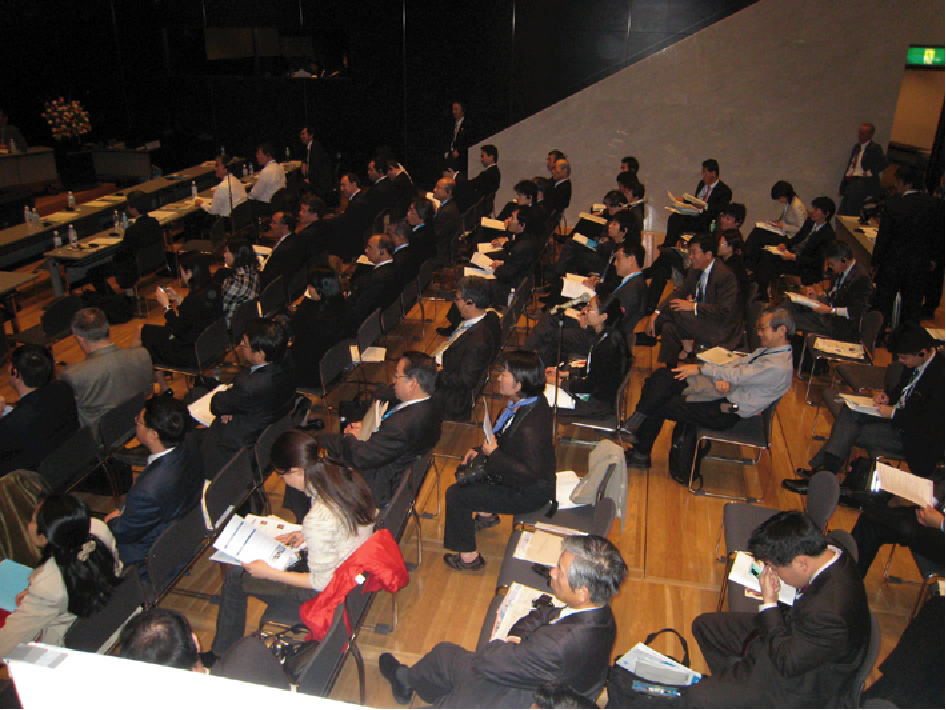 |
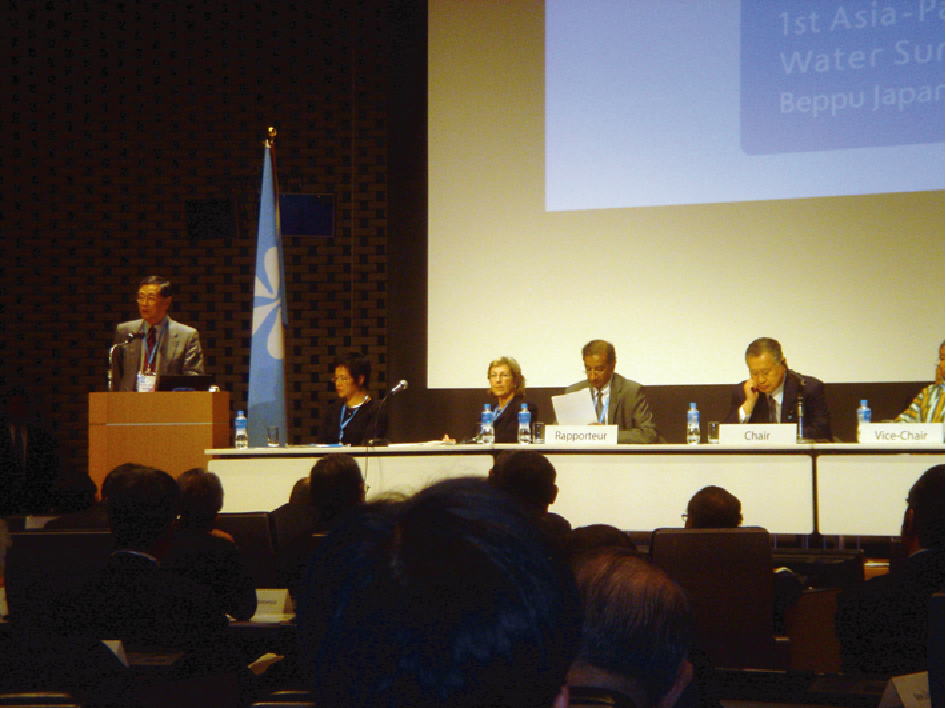 | |||||||
| Participants intently
listens to lectures at the Summit auditorium.. | Dr.
Takeuchi reports the results of the topic session at the closeing ceremony. | |||||||
| | ||||||||
| 6. (Attended) International Conferences | ||||||||
| i. The UNESCO-IHE Course (1. ~ 5. Oct.) | ||||||||
| ||||||||
| ii. Regional Consultation Meeting for
Candidate Water Knowledge Hubs (29. ~ 30. Oct.) | ||||||||
|
The Regional Consultation Meeting for Candidate Water Knowledge Hubs was held at the Singapore Public Utility Board on September 29-30, 2007. A total of 26 representatives from 14 organizations participated in the meeting and discussed for establishing a novel network, called "water knowledge hubs", to share knowledge and experience on water management among Asia-Pacific countries. Deputy Director Akira Terakawa and Research Scientist Yoganath Adikari attended from ICHARM. The NARBO (Network of Asian River Basin Organizations) secretariat, hosted by the Japan Water Agency, also sent representatives to the meeting. |
The meeting was a part of the preparation process for the
Asia-Pacific Water Summit, which was held on December 3-4, 2007, in Beppu,
Kyushu, Japan. Dr. Wouter Lincklaen Arriens, Lead Water Resources Specialist of
ADB (Asian Development Bank) and Dr. Jan Luijendijk,
Professor of UNESCO-IHE, led the meeting, where each participating organization
made a presentation on the outline of its activities and collaboration strategies
with related organizations. Each presentation was followed by discussion among
the participants. When the two-day meeting concluded, a consensus was reached to the effect that ICHARM would be a candidate water knowledge hub on water related disaster management in the region. | |||||||
|
| ||||||||
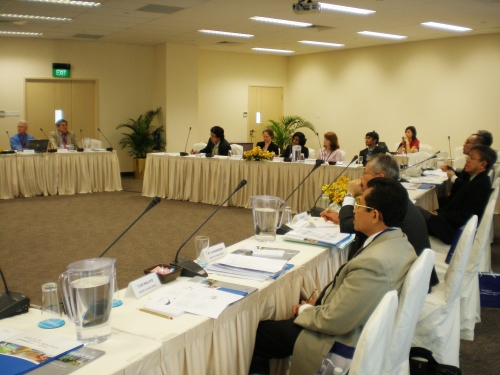 |
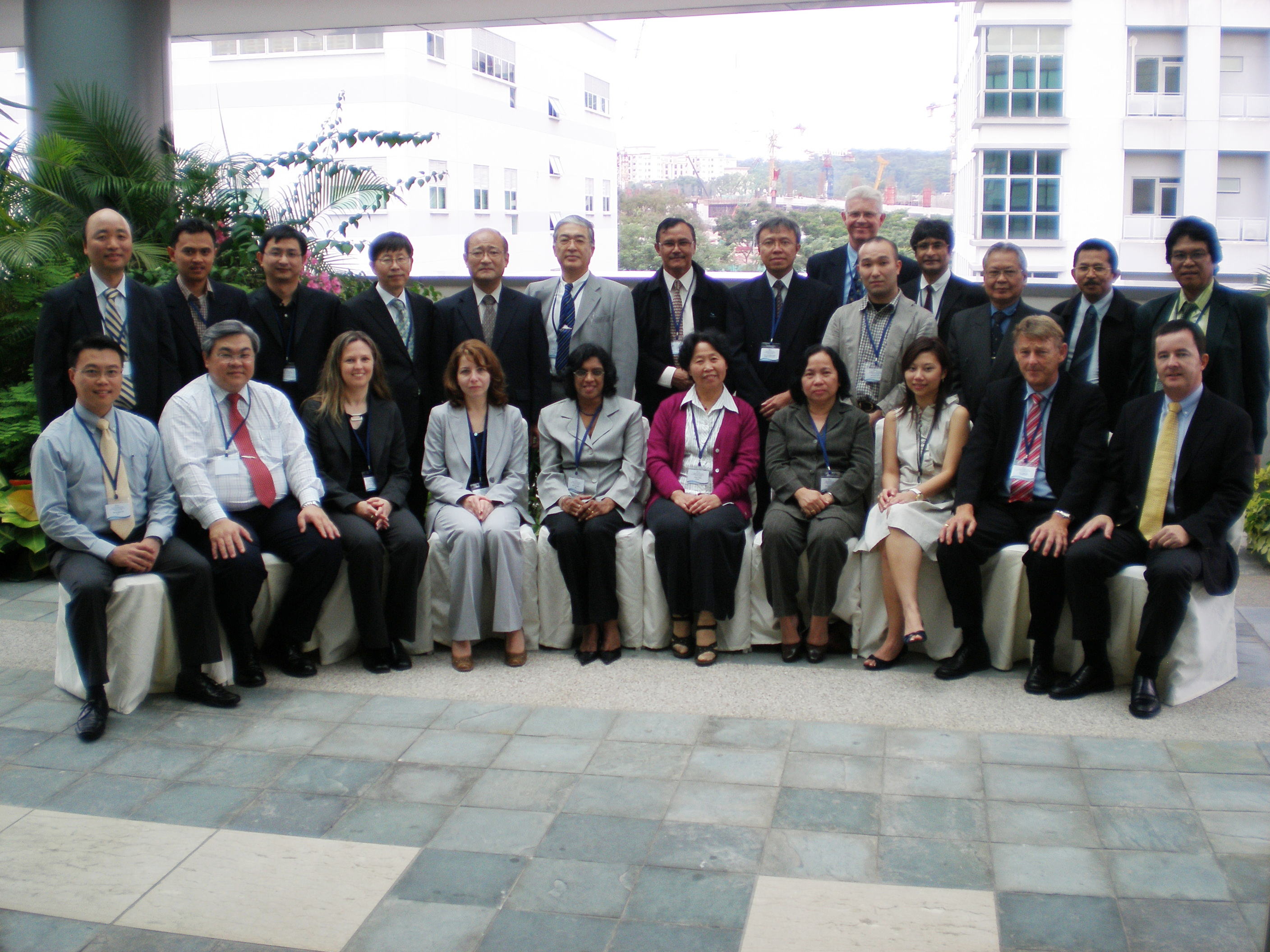 | |||||||
| The meeting was hosted
by the Singapore Public Utility Board (PUB) | Group photo of the participants | |||||||
| iii. Workshop on the Evaluation
of High Resolution Precipitation Products, Geneva, Switzerland (3. ~ 5. Dec.) | ||||||||
|
The Program to Evaluate High Resolution Precipitation Products (PEHRPP) held a workshop on "Evaluation of High Resolution Precipitation Products" at the World Meteorological Organization (WMO) headquarters in Geneva, Switzerland from December 3-5, 2007. The first of the two main objectives is to provide recommendations to the IPWG and Integrated Global Water Cycle Observations (IGWCO). The second objective is to discuss how PEHRPP
can link to and support other international activities related to precipitation,
including the Global Precipitation Measurements (GPM) Mission and atmospheric,
hydrologic and climate modelers, and potentially to operational weather services. Dr. Prasantha Hapuarachchi, a researcher of the hydrologic engineering
research team represented ICHARM and gave a presentation on "Applicability
of satellite based precipitation data for near real-time flood forecasting".
|
He presented the validation results (ICHARM-JAXA joint research) of the latest very high resolution precipitation product, called "Global Satellite Mapping of Precipitation (GSMaP)", developed at the Osaka Prefecture University (Project Leader: Professor Kenichi Okamoto), Japan, and some other products developed by NASA and NOAA. It is the first time for scientists outside Japan to know about the GSMaP characteristics since the GSMaP data were open to public just in November, 2007. Dr. Hapuarachchi presented the results of an application of satellite based precipitation for river flow modeling in the Yoshino River basin in Japan and the error characteristics too. 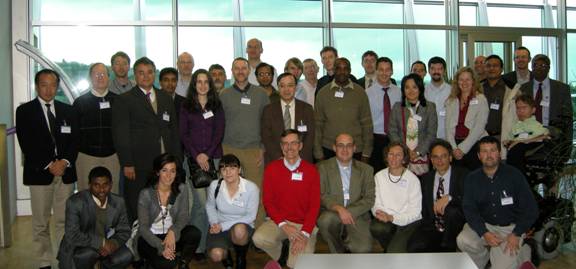 PEHRPP workshop participants.
PEHRPP workshop participants. | |||||||
| | ||||||||
| 7. Visiters to ICHARM | ||||||||
| i.
Guest from UNESCO (7. Dec.) | ||||||||
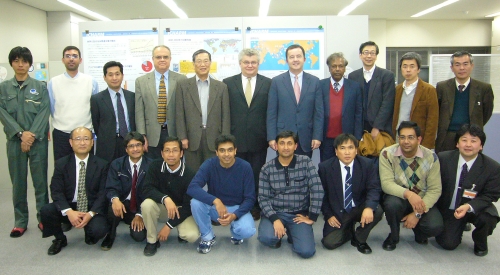 |
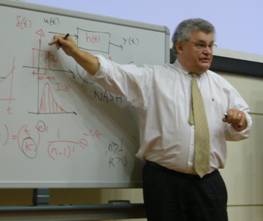 | |||||||
|
| |||||||
| | ||||||||
| 8. Coming Events | ||||||||
| i.
Follow-up seminar on Flood Mapping in China (30. Jan. ~ 1. Feb.) | ||||||||
|
IICHARM will organize the 2nd regional seminar entitled "Flood Hazard Mapping For Flood Hazard & Risk Management in East & Southeast Asia Regions" in China from January 30 to February 1 in collaboration with the Japan International Cooperation Agency (JICA) and two Chinese agencies, the Office of State Flood Control and Drought Relief Headquarters (OSFCDRH) and the Department of Water Hazard Research of the China Institute of Water Resources and Hydropower Research (IWHR). In this seminar, in order to strengthen the capacity of professionals who acquired knowledge on FHM through trainings in Japan and are involving in flood management in their home countries, exchanging appropriate information and discussion will be conducted. | ||||||||
|
Information | ||||||||
Copyright (c) 2008 Public Works Research Institute
|
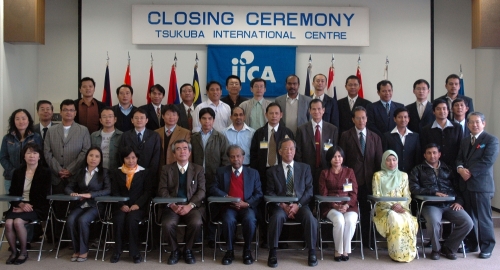
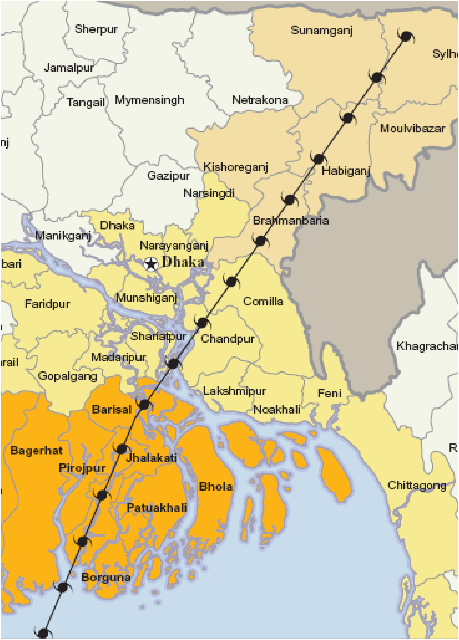
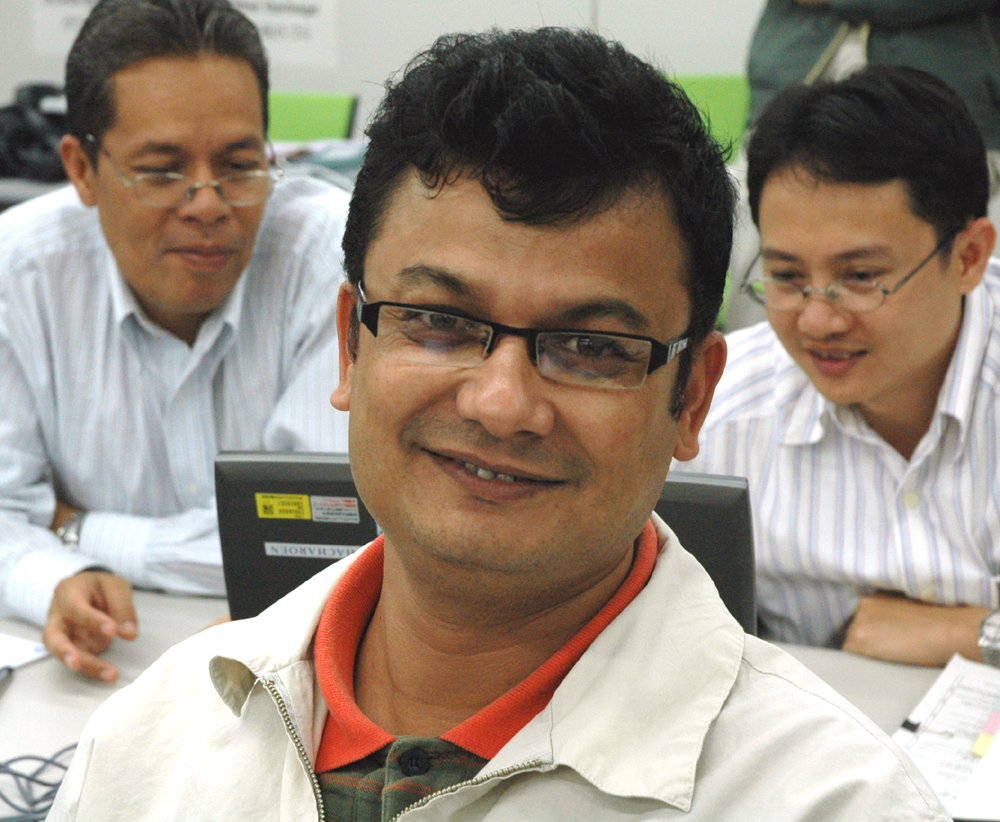
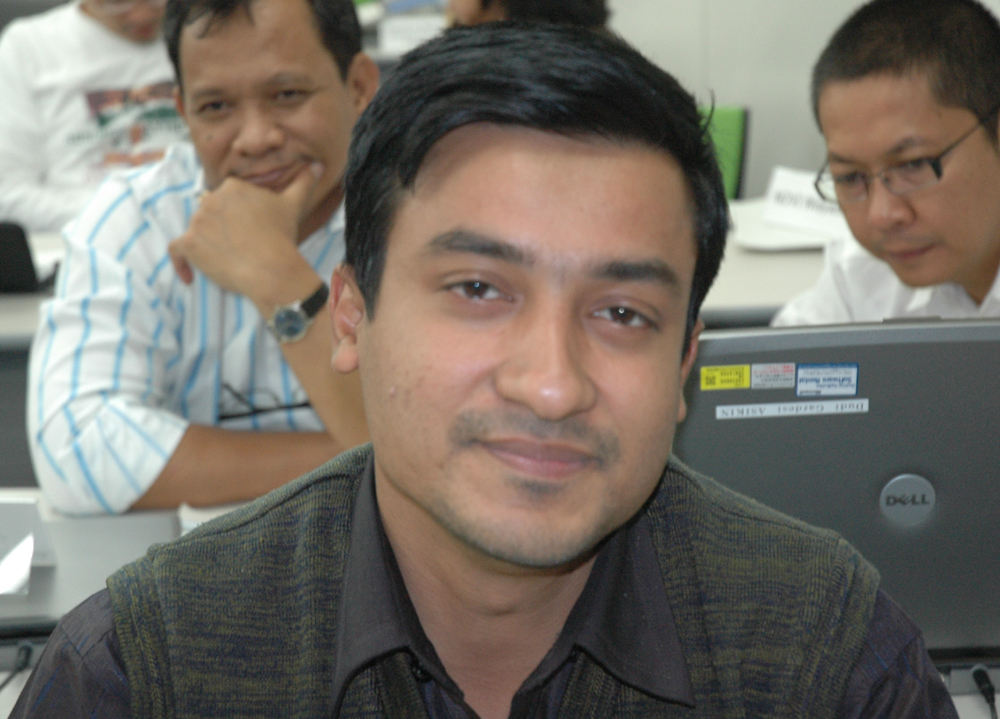
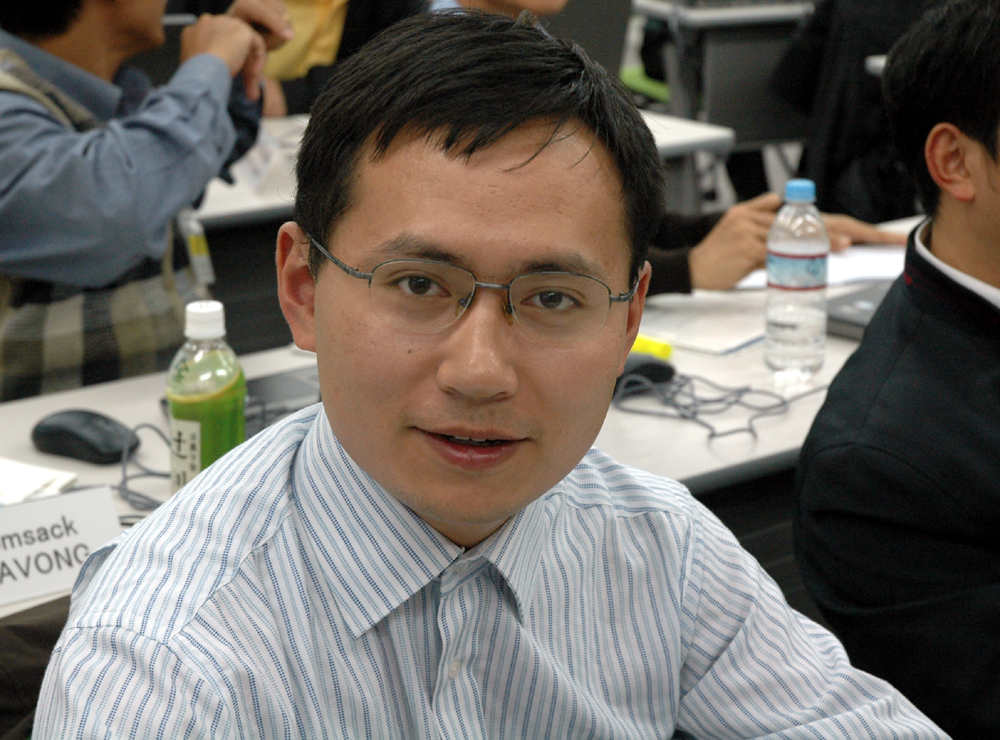
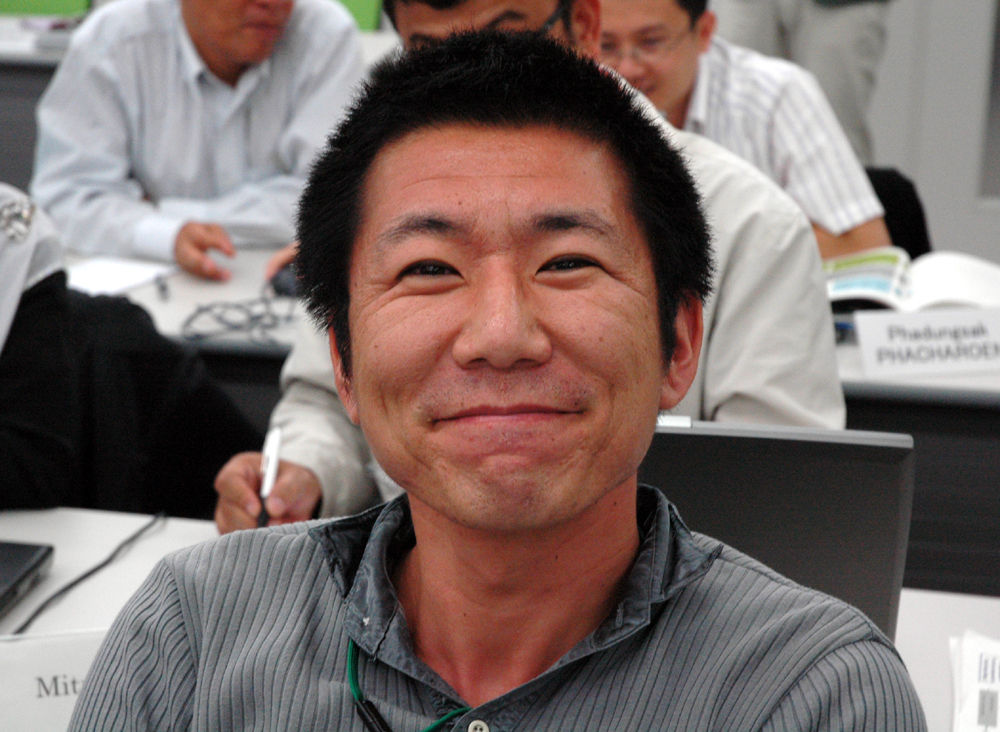
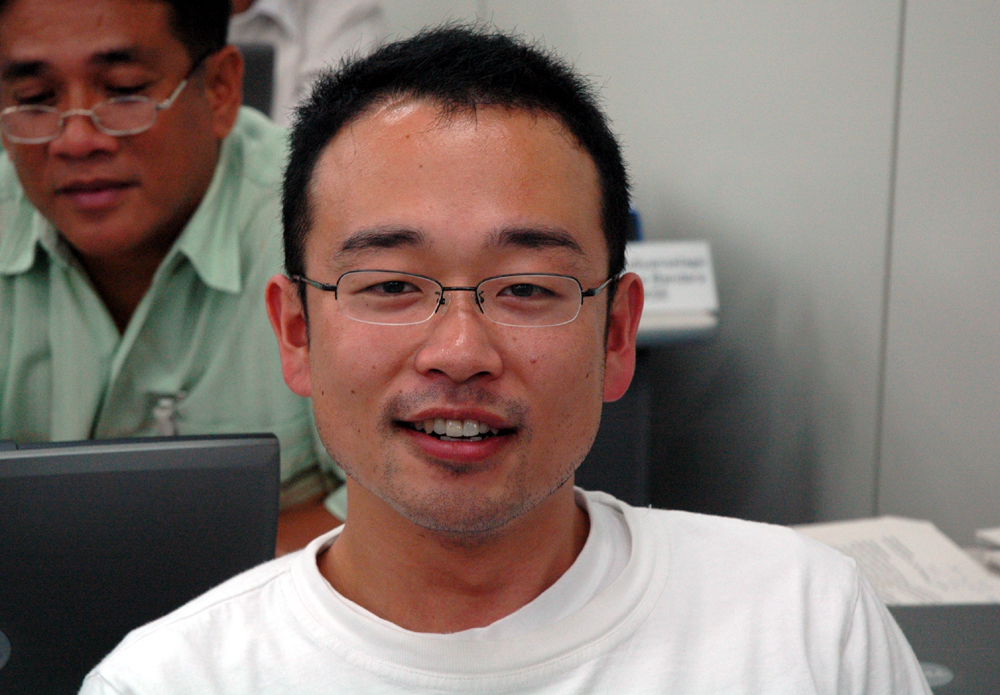

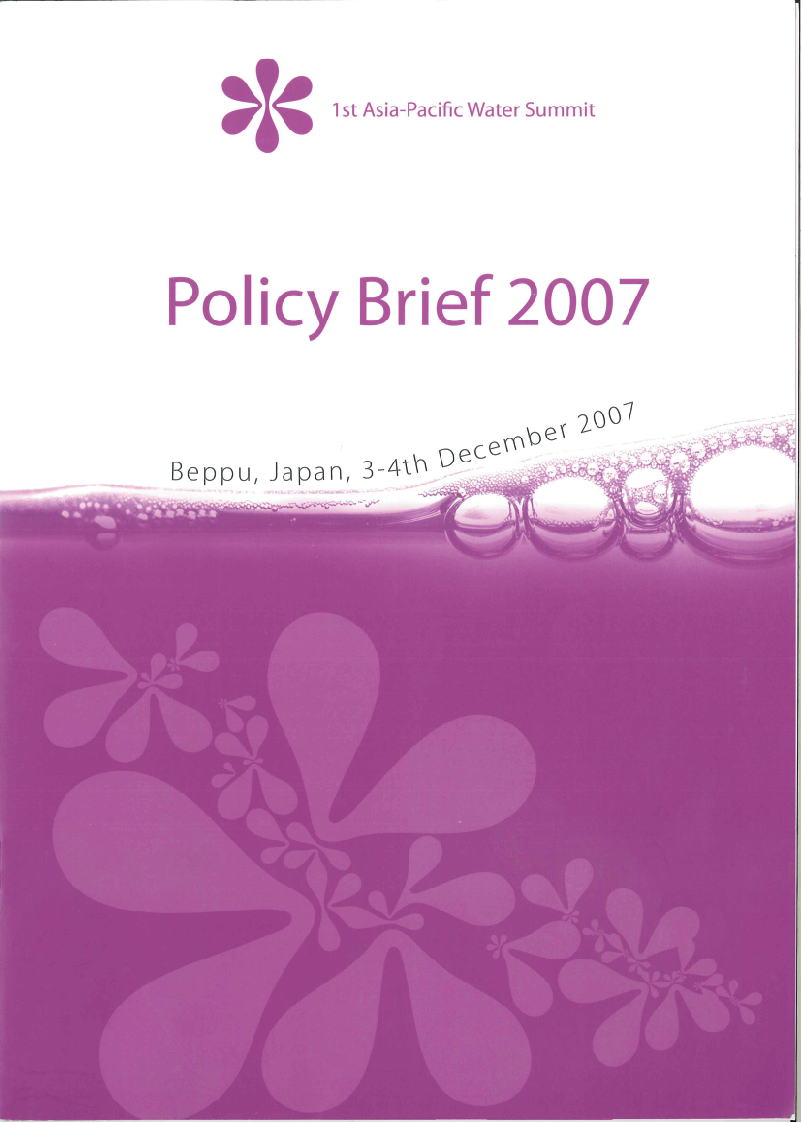
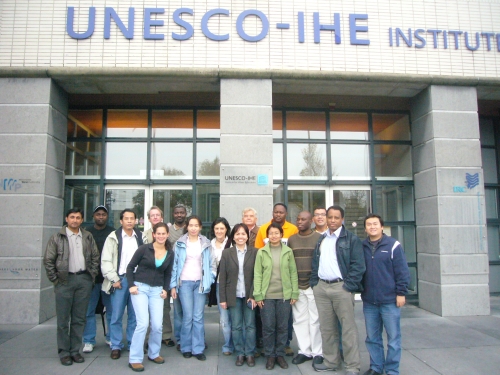 Course participants including instructors
Course participants including instructors